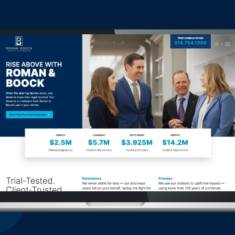Make It Right: The Value of an ADA Website Audit and Redevelopment
02.17.23
Accessibility means meeting the needs of everyone in your business audience, including those with disabilities. By conducting an ADA website audit and making a few adjustments to your website, you eliminate audience barriers and avoid potential legal complications. The most accessible websites are crafted by an experienced agency partner.
Read on to learn why accessible marketing matters and how we meet website compliance requirements.
Why does accessible marketing matter?
Accessibility standards open doors for your company, acting as a substantial source of security, positive perception and economic growth. Generally, accessibility concerns boil down to three factors.
- Legality. Laws such as the Americans with Disabilities Act (ADA) and Section 508 of the Rehabilitation Act of 1973 require businesses to keep digital platforms equitable and accessible. If an ADA website audit determines that you failed to comply with established standards under these pieces of legislation, you may be subject to an ADA-compliant website lawsuit.
- Diversity, Equity & Inclusion. A lack of accessible marketing could be considered discriminatory, which may encourage feelings of distrust and anger among your consumers. By building the most accessible websites, you position your brand as inclusive, authentic and equitable in all aspects of your marketing strategy. By dedicating time to an ADA-compliant website, you are actively crafting a positive public image for your brand.
- Opportunity. One billion people worldwide live with some form of disability. If your website is inaccessible, you’re missing out on business from a large portion of the world market. It’s in your company’s meet website compliance requirements and be accessible to all.
How do you create an ADA-compliant website?
ADA compliance relies on recommendations from the Web Content Accessibility Guidelines (WCAG) — an internationally recognized guide released by W3C. Their accessible marketing standards revolve around four principles, which we use to guide our ADA website audits. Brands should examine these standards before their site goes live in order to avoid ADA-compliant website lawsuits.
- Perceivable. All audience members should be able to perceive your content without losing its meaning. Most of the time, this means making it easier for users to see and hear content across digital platforms. Perceivable content on most accessible websites may involve:
-
- Providing text alternatives for multimedia content such as transcripts.
- Providing captions, audio descriptions, sign language interpretation or other options.
- Creating presentation options capable of translating to assistive technology.
- Operable. Users should be able to traverse your website quickly and easily, regardless of their ability. In accordance with website compliance requirements, your interface must:
-
- Give users ample time to read the content.
- Allow for all functionality to be accessible through the keyboard, such as the ability to use arrow keys to navigate form elements.
- Help users find content easily — for example, an ADA website audit should reveal that there is more than one way to locate each web page.
- Understandable. The content and user interface on most accessible websites should be easy to understand. Accessible marketing will play into user intuition by:
-
- Making text legible.
- Making content consistent and predictable.
- Explaining errors and helping users correct them.
- Robust. Content must be robust enough for assistive technologies to interpret it. Your website must maximize compatibility with current and future technologies — this may mean maintenance as technology evolves with new or revised accessible features.
What are the levels of ADA compliance?
You must strive to feature all four principles of accessible marketing without impacting the functionality or tone of your site. However, the implementation of website compliance requirements is not a one-size-fits-all approach — rather, there are three levels of conformance for an ADA-compliant website that fit the needs of different groups. Our ADA website audits may determine that you fit into one level but may need to improve to avoid the chance of an ADA-compliant website lawsuit.
WCAG Level A
WCAG Level A is the most basic level of ADA conformance. The features involved are easy to implement without impacting your site’s structure. For example, Level A would require you to provide captions for non-text media, such as videos on your site. However, this level does not mean you are considered among the most accessible websites — the features may not be enough to meet users needs or appease those in the legal sphere.
WCAG Level AA
WCAG Level AA is often considered a good standard for accessibility. The features involved are more comprehensive and may impact your site structure. For example, Level AA would require you to provide synchronized captions for live audio content. This level is the official standard for an ADA-compliant website in countries such as the United Kingdom, Germany, Canada and India.
WCAG Level AAA
WCAG Level AAA includes the most comprehensive website compliance requirements. This is a standard for accessible marketing that we rarely see in our ADA website audits. It involves strict benchmarks and is generally considered the ultimate goal for web developers. For example, Level AAA would require that you provide sign language interpretation for pre-recorded audio and alternative media that conveys the same message for live content. If your website is Level AAA, your platform would be considered one of the most accessible websites.
At Paradigm, our web developers strive to reach the highest level of compliance for each client. We tailor functionality and other features to fit your audience’s needs and protect you from legal action. Regardless of the state of your site, our team brings you up to the latest accessible marketing standards established by WCAG and helps you limit your chances of an ADA-compliant website lawsuit.
How do I know if I’m compliant?
The first step toward an ADA-compliant website is partnering with a web development firm to perform an ADA website audit. Web developers analyze your website for potential flaws and identify steps toward remediation. They spot things you may miss internally, such as error codes or designs that do not adhere to color contrast standards.
Without a tried-and-true accessible marketing partner, your business may face legal challenges. Paradigm has over 25 years of experience creating the most accessible websites across industries — contact our team to create a website up to 2024 website compliance requirements.


